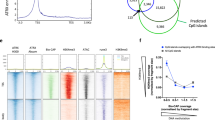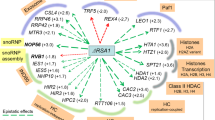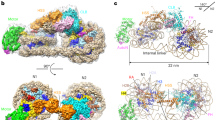ABSTRACT
Our previous study showed that hydroxyurea (Hu) could induce HEL cells to express human b-globin gene. However the molecular mechanisms by which the expression of β-globin gene is activated and regulated are poorly understood. Here we show that the binding patterns between the core DNA sequences (HS2 core sequence −10681 ∼ −10971 bp, HS3 core sequence −14991 ∼ −14716 bp and HS4 core sequence −18586 ∼ −18306 bp) of DNase I hypersensitive sites in the human β-globin LCR and nuclear matrix proteins isolated from Hu induced and uninduced HEL cells are quite different. Results demonstrated that nuclear matrix proteins might play important roles in regulating the expression of human β-like globin genes through their interaction with HSs (HS2,HS3 and HS4 core sequences) in the LCR. Moreover, the results obtained from the in vitro DNA-matrix binding assay showed that the core DNA sequences of DNase I hypersensitive sites (HS2, HS3 and HS4) were unable to bind to the nuclear matrix isolated from uninduced HEL cells; in addition, HS2 core DNA sequence was capable of binding to the nuclear matrix prepared from Hu-induced HEL cells, while both HS3 and HS4 core DNA sequences could not do so. Results indicated that the HS2 core DNA sequence may be a functional MAR (matrix attachment region). We suggest that the HS2 core DNA sequence binding to the nuclear matrix in Hu-induced HEL cells may open the structure of chromatin to make the LCR accessible to the promoter of β-globin gene and to promote its transcription.
Similar content being viewed by others
INTRODUCTION
The nuclear matrix is operationally defined as a nonchromatin structural network. It plays a very important role in controlling nuclear basic structure, chromatin structure, DNA replication and transcription. Previous studies showed that actively transcribed gene were preferentially associated with nuclear matrix. Moreover, there are a large quantity of proteins which are related to the regulation of gene transcription in nuclear matrix, indicating that both nuclear matrix and nuclear matrix proteins might be involved in the regulation of eukaryotic gene expression1.
HEL cells (a human erythroleukemia cell line) mainly express the human fetal (γ) globin gene and trace amount of embryonic (ε)globin gene, but not adult (β) globin gene2.
Hydroxyurea (Hu) has been used to treat patients with sickle-cell anemia and beta-thalassemia, and known to be effective in increasing the level of HbF (fetal hemoglobin) in patients' blood. Later, Huang et al found that it could also increase the expression of adult (β) globin gene in patients with b-thalassemia3. Recently, we have demonstrated that Hu can induce HEL cells to express adult (β)-globin gene and lead these cells to terminal differentiation4
The locus control region (LCR) in human β-like globin genes consists of five DNase I hypersensitive sites (HSs 1-5). It is known that LCR may play a critical role in the regulation of developmental stage-specific b-globin gene expression. HS2 functions as a powerful erythroid-specific enhancer. Moreover, HS3 may be related to the regulation of ε-globin gene expression during embryonic period, while HS4 may play a major role in the expression of β-globin gene5.
In this report, HEL cells were used as a model to study the binding patterns between core DNA sequences of DNase I hypersensitive sites (HS2,HS3 and HS4) and nuclear matrix proteins via DNA binding assays. Results obtained suggest that both nuclear matrix and nuclear matrix proteins in HEL cells are involved in the regulation of human β-globin gene expression through their interaction with core DNA sequences of DNase I hypersensitive sites.
MATERIALS AND METHODS
HEL cell culture
HEL cells were maintained in RPMI-1640 medium (GIBCO-BRL) supplemented with 10% newborn calf serum, penicillin (50 μg/ml), streptomycin (100 μg/ml) and glutamine (300 μg/ml). HEL cells were induced by hydroxyurea (Sigma) at the final concentration of 150 μM for 24 h.
RT-PCR analysis
HEL cells were cultured with 150 mM of hydroxyurea for 12, 24 h at 37°C After incubation, total RNA was prepared and RT-PCR assays were performed as described previously4.
Preparation of DNA probes
HS2 core sequence (−10681 ∼ −10971 bp), HS3 core sequence (−14991 ∼ −14716 bp), HS4 core sequence (−18586 ∼ −18306 bp) and a DNA fragment in the 5' flanking sequence of human β-globin gene (−371 ∼ +20, termed b-PRE) were cloned respectively and prepared with restriction enzymes according to the method described by Zhang et al4. These probes were labeled with (α - 32P)-ATP.
Isolation of nuclear matrix (NM) and the in vitro DNA-matrix binding assay
The isolation of NM and the in vitro DNA-matrix binding assay were performed according to the method described by Cockerill and Garrard6. Matrices were washed 3 times with washing buffer (50 mM NaCl, 1 mM MgCl2, 10 mM Tris-HCl, pH 7.4, 0.5 mM PMSF, 0.25 mg/ml BSA). Binding was performed by incubation of the nuclear matrix with 90 ml of assay solution (50 mM NaCl, 2 mM EDTA, 10 mM Tris-HCl, pH 7.4, 0.5 mM PMSF, 0.25 mg/ml BSA, 5 ∼ 10 ng of 32P-end-labeled DNA fragment mixture, and 20 mg of unlabeled, sonicated E.coli DNA) shaking for 1 h at 23 °C. DNA fragments that interact with the matrix were separated from free DNA by centrifugation (10,000×g) for 10 min at 4 °C. After washing with 1 ml of final washing buffer (50 mM NaCl, 2 mM EDTA, 10 mM Tris-HCl, pH 7.4, 0.5 mM PMSF, 0.25 mg/ml BSA), the protein-DNA complex was solubilized in 15 ml of solubilizing buffer (2 mM EDTA, 40 mM Tris-HCl, pH 7.4, 0.4 mg/ml proteinase K, 0.5% SDS, and 5 mg/ml sonicated salmon sperm DNA) and incubated overnight at 37°C Resulting matrix-bound DNA fragments were resolved by polyacrylamide gel electrophoresis
The preparation of NM proteins and EMSA assay
The nuclear matrix proteins were prepared from Hu-induced and uninduced HEL cells according to the method described by Merriman7. The protein concentration was determined according to Bradfords's method8. Gel mobility shift assays were performed as described previously 9.
RESULTS
The expression of human β-globin gene in hydroxyurea-induced HEL cells identified by using RT-PCR analyses
HEL cells mainly express the human γ-globin gene and trace amount of ε-globin gene, but not adult β-globin gene. RT-PCR analyses demonstrated that human β-globin gene was expressed in HEL cells induced by Hydroxyurea (150 mM) for 12,24 h (Fig 1, lanes 2-3). In addition, b-globin gene expression could not be detected in un-induced HEL cells (Fig 1, lane 1). It is of interest to investigate why HU can induce the expression of human β-globin gene in HEL cells and how the nuclear matrices play their roles.
RT-PCR analysis of human β-globin gene expression in both the HU-induced and un- induced HEL cells Lane 1: HEL cells were cultured without the induction of HU; Lane 2: HEL cells were cultured with 150 μM of HU for 12 h; Lane 3: HEL cells were cultured with 150 μM of HU for 24 h; Lane M: Molecular weight marker.
Analysis of core DNA sequences of DNase I hypersensitive sites (HS2, HS3 and HS4) binding to nuclear matrices isolated from both Hu-induced and uninduced HEL cells
The results obtained from the DNA-matrix binding assay in vitro showed that the DNA fragment (−371 ∼ +20, termed b-PRE) in the 5' flanking sequence of human b-globin gene could bind to the nuclear matrices prepared from both Hu induced and uninduced HEL cells (Fig 2A–C, Lanes 1, 2 Band A). It suggests that this regulatory element might be a constitutive nuclear matrix attachment region (MAR). In order to further explore the interaction between the core DNA sequences of DNase I hypersensitive sites in the human β-globin LCR and nuclear matrix, both the labeled core DNA sequence (HS2, HS3 or HS4) and labeled β-PRE were incubated with nuclear matrices prepared from Hu-induced and uninduced HEL cells. Results showed that HS2 core DNA sequence could not bind to nuclear matrix isolated from uninduced HEL cells while it was capable of binding to nuclear matrix prepared from Hu-induced HEL cells (Fig 2A, Lanes 1, 2 Band B); both HS3 and HS4 core DNA sequences couldn't bind to the nuclear matrix isolated from uninduced HEL cells (Fig 2B-C, Lane 1), neither could they bind to the nuclear matrix prepared from Hu-induced HEL cells (Fig 2B–C, Lane 2). It indicated that HS2 core DNA sequence might be a facultative MAR.
The in vitro DNA-matrix binding assay Binding assay was performed according to the procedures as described in materials and methods. Both Labeled HSs core DNA sequences and labeled βPRE DNA fragment were used as probes
A. HS2 core DNA sequence (-10681-10971 bp) binding to nuclear matrix isolated from Hu-induced and uninduced HEL cells. Both labeled HS2 core DNA sequence and labeled β-PRE DNA fragment were used as Probes Lane M: Both labeled HS2 core DNA sequence and labeled β-PRE DNA fragment as makers; Lane 1: Both labeled HS2 core DNA sequence and labeled b-PRE DNA fragment were incubated with nuclear matrix separated from uninduced HEL cells; Lane 2: Both labeled HS2 core DNA sequence and labeled β-PRE DNA fragment were incubated with nuclear matrix separated from Hu-induced HEL cells.
B.? HS3 core sequence (-14991-14716 bp) binding to nuclear matrix isolated from Hu-induced and uninduced HEL cells. Both labeled HS3 core DNA sequence and labeled β-PRE DNA fragment were used as probes Lane M: Both labeled HS3 core DNA sequence and labeled b-PRE DNA fragment as makers; Lane 1: Both labeled HS3 core DNA sequence and labeled β-PRE DNA fragment were incubated with nuclear matrix separated from uninduced HEL cells; Lane 2: Both labeled HS3 core DNA sequence and labeled b-PRE DNA fragment were incubated with nuclear matrix separated from Hu-induced HEL cells.
C. HS4 core sequence (−18586 ∼ −18306 bp) binding to nuclear matrix isolated from Hu-induced and uninduced HEL cells. Both labeled HS4 core DNA sequence and labeled b-PRE DNA fragment were used as probes Lane M: Both labeled HS4 core DNA sequence and labeled β-PRE DNA fragment as makers; Lane 1: Both labeled HS4 core DNA sequence and labeled b-PRE DNA fragment were incubated with nuclear matrix separated from uninduced HEL cells; Lane 2: Both labeled HS4 core DNA sequence and labeled β-PRE DNA fragment were incubated with nuclear matrix separated from Hu-induced HEL cells.
The binding patterns of nuclear matrix proteins with the core DNA sequences of DNase I hypersensitive sites (HS2, HS3 and HS4) in LCR
In order to further investigate the function of nuclear matrix proteins in the regulation of b-globin gene expression, EMSAs were performed. Data revealed that the patterns of nuclear matrix proteins binding to the core DNA sequences of DNase I hypersensitive sites (HS2, HS3 and HS4) were apparently different in Hu-induced and uninduced HEL cells. Using labeled HS2 core DNA sequence as a probe, three bands (Band A, C and D) could be detected with the nuclear matrix proteins separated from uninduced HEL cells (Fig 3A, Lane 2); while the intensity of Band A was increased and a new band (Band B) was detectable with nuclear matrix proteins from Hu-induced HEL cells (Fig 3A, Lane 3). When labeled HS3 core DNA sequence was used as a probe, at least, five bands (Band E, F, G, H and I) could be detected with nuclear matrix proteins from un-induced HEL cells (Fig 3B, Lane 2); only three bands (Band G, H and I) could be observed with the nuclear matrix proteins from Hu-induced HEL cells (Fig 3B, Lane 3). EMSA was also carried out to reveal the binding of nuclear matrix proteins to HS4 core DNA sequence. Two bands (Band J and K) could be detected with the nuclear matrix proteins from un-induced HEL cells (Fig 3C, Lane 2); while the intensity of Band K was increased and Band Jwas decreased with the nuclear matrix proteins from Hu-induced HEL cells (Fig 3C, Lane 3). These results indicate that nuclear matrix proteins are involved in regulating the expression of human β-globin gene through their interaction with LCR.
The interaction of nuclear matrix proteins with the core DNA sequences of DNase I hypersensitive sites(HS2, HS3 and HS4) in LCR
A.? The interaction between HS2 core DNA sequence and nuclear matrix proteins separated from both Hu-induced and uninduced HEL cells Lane 1: Labeled HS2 core DNA sequence without nuclear matrix proteins; Lane 2: Labeled HS2 core DNA sequence with 1μg nuclear matrix protein separated from uninduced HEL cells; Lane 3: Labeled HS2 core DNA sequence with 1μg nuclear matrix protein separated from Hu-induced HEL cells.
B. The interaction between HS3 core DNA sequence and nuclear matrix proteins separated from both Hu-induced and uninduced HEL cells Lane 1: Labeled HS3 core DNA sequence without nuclear matrix proteins; Lane 2: Labeled HS3 core DNA sequence with 1μg nuclear matrix protein separated from uninduced HEL cells; Lane 3: Labeled HS3 core DNA sequence with 1μg nuclear matrix protein separated from Hu-induced HEL cells.
C.? The interaction between HS4 core DNA sequence and nuclear matrix proteins separated from both Hu-induced and uninduced HEL cells Lane 1: Labeled HS4 core DNA sequence without nuclear matrix proteins; Lane 2: Labeled HS4 core DNA sequence with 1 μg nuclear matrix protein separated from uninduced HEL cells; Lane 3: Labeled HS4 core DNA sequence with 1 μg nuclear matrix protein separated from Hu-induced HEL cells.
DISCUSSION
It has been shown that locus control region can stimulate transcription from promoters over long distance through changing the model of transcription factors binding to LCR or LCR -mediated changes in chromatin structure10,11. In the later mechanism nuclear matrix takes active part in regulating the structure of chromatin12.
Our results showed that the binding patterns of the nuclear matrix proteins isolated from both the Hu-induced and uninduced HEL cells to HSs (HS2, HS3 and HS4) core DNA sequences were quite different. It implies that the nuclear matrix proteins in vivo might play an important role in the regulation of β-globin gene expression through the selective binding to LCR sequences.
In addition, studies show that the β-globin LCR is required for decondensation of higher order chromatin and the high-level expression of globin genes13, 14, 15. Using the DNA-matrix binding assay in vitro, data revealed that the HS2 core DNA sequence could bind to nuclear matrix isolated from Hu-induced HEL cells. We suggest that HS2 core DNA may be a functional MAR (matrix attachment region). The chromatin structure of LCR in Hu-induced HEL cells might be changeable through HS2 binding to nuclear matrix. Interaction of HS2 core DNA sequence with nuclear matrix may result in the formation of chromatin loops that juxtapose regulatory elements (HS2 enhancer and β-globin gene promoter), which in turn stimulates the expression of human β-globin gene in Hu-induced HEL cells. Moreover, It has been reported that HS4 may play an important role in the expression of β-globin gene5. However, our data from the DNA-matrix binding assay in vitro showed that HS4 core DNA sequence couldn't bind to nuclear matrices prepared from both Hu-induced and uninduced HEL cells, indicating that it would not be a MAR. We hypothesize that HS4 core DNA sequence may stimulate transcription through changing the model of the transcription factors binding to it.
References
Edward G Fey, Peter Bangs, Cynthia Sparks, Paul Odgren . The nuclear matrix: defining structural and functional roles. Eukaryotic gene expression 1991; 1:127–43.
Marin P, Papayannopoulou T . HEL cells: a new erythroleukemia cell line with spontaneous and induced globin expression. Science 1982; 216(4551):1233–5.
Huang SZ, Ren ZR, Chen MJ, XU HP, Zeng YT, Rodgers GP, Zeng FY, Schechter AN . Treatment of b-thalassemia with hydroxyurea (Hu). Science in China 1994; 37:1350–9.
Zhang SB, He QY, Zhao H, Gui CY, Jiang C, Qian RL . Function of GATA transcription factors in hydroxyurea-induced HEL cells. Cell Research 2001; 11(4):301–10.
Fraser P, Pruzina S, Antoniou M, Grosveld F . Each hypersensitive site of the human b-globin locus control region confers a different developmental pattern of expression on the globin genes. Genes Dev 1993; 7:106–13.
Peter N. Cockerill and William T. Garrard . Chromosomal loop anchorage of the kappa immunoglobulin gene occurs next to the enhancer in a region containing topoisomeraseII sites. Cell 1986; 44:273–82.
Merriman HL, Van wijnen AJ, Hiebert S, et al. The tissue-specific nuclear matrix protein, NMP-2, is a member of the AML/CBF/PEBP2/runt domain transcription factor family: interactions with the osteocalcin gene promoter. Biochemistry 1995; 34:13125–32.
Bradford, MM . A rapid and sensitive method for the quantitation of microgram quantities of protein utilizing the principle of protein-dye binding. Anal Biochem. 1976; 72:248–54.
Yan ZJ, Chen YD, Qian RL . Development stage-specific factors in the mouse hematopoietic tissues binding to the 5'-flanking cis-acting elements of human e-globin gene. Chinese Science Bulletin 1995; 40:778–83.
Ikonomi P, Noguchi CT, Miller W, Kassahun H, Hardison R, Schechter AN . Levels of GATA-1/GATA-2 transcription factors modulate expression of embryonic and fetal hemoglobins. Gene 2000; 261:277–87.
Teni Boulikas . Homeodomain protein binding sites, inverted repeats, and nuclear matrix attachment regions along the human b-globin gene complex. Journal of Cellular Biochemistry 1993; 52(1):23–36.
Lakshmi Akileswaran, Justin W Taraska, Jonathan A. Sayer, et al. A-kinase-anchoring protein AKAP95 is targeted to the nuclear matrix and associates with p68 RNA helicase. The Journal of Biological Chemistry 2001; 276:17448–54.
Tang Y, Qian RL . HS3 of the mouse β-LCR. Chinese Science Bulletin 1997; 42:2090–3.
Forrester, WC, Epner E, Driscoll, MC, Enver T, Brice M, Papayannopoulou T, Groudine M . A deletion of the human b-globin locus activation region causes a major alteration in chromatin structure and replication across the entire b-globin locus. Genes Dev 1990; 4:1637–49.
Stamatoyannopoulus G . Human hemoglobin switching. Science 1991; 252:383.
Acknowledgements
Acknowledgements: This work was supported by the National Natural Science Foundation of China (Grant No.39893320 and 39870378) and the Foundation of the Chinese Academy of Sciences (Grant No. KJ982-J1-618).
Author information
Authors and Affiliations
Corresponding author
Rights and permissions
About this article
Cite this article
ZHANG, S., QIAN, R. The interaction between the human β-globin locus control region and nuclear matrix. Cell Res 12, 411–416 (2002). https://doi.org/10.1038/sj.cr.7290144
Received:
Revised:
Accepted:
Issue Date:
DOI: https://doi.org/10.1038/sj.cr.7290144






